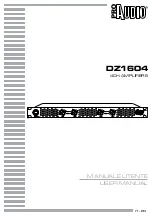
13
SOLO/610 Overview
The SOLO/610 is a vacuum-tube microphone/instrument/line preamplifier and DI (direct input) box in a
convenient portable lunchbox form factor. The function of a preamplifier, as its name implies, is to
increase (or amplify) the level of an incoming signal to the point where other devices in the chain can
make use of it. The output level of microphones is very low and therefore requires specially designed
mic preamplifiers to raise their level to that needed by a mixing console, tape recorder, or digital audio
workstation (DAW) without degrading the signal to noise ratio. This is no simple task, especially when
you consider that mic preamps may be called upon to amplify signals by as much as 1000%.
Through careful attention to design and the use of vacuum tubes, which are carefully selected and
tested individually, we believe we’ve succeeded. The SOLO/610 is a versatile, easy-to-use mic
preamplifier with unmatched sonic characteristics, similar to that of the original 610, but with lower
noise.
The SOLO/610 has two separate gain stages, each of which utilizes a dual-triode tube operating in a
class A single-ended configuration. Variable negative feedback is applied to both of these stages to
control gain, reduce distortion, and extend frequency response. Our transformer design features
double-sized alloy cores with custom windings, and all balanced inputs and outputs are transformer
coupled.
About “Class A”
Most electronic devices can be designed in such a way as to minimize a particularly unpleasant form
of distortion called
crossover distortion.
However,
the active components in “Class A” electronic
devices such as the SOLO/610 draw current and work throughout the full signal cycle, thus eliminating
crossover distortion altogether.
About Negative Feedback
Negative feedback is a design technique whereby a portion of the preamplifier’s output signal is
reversed in phase and then mixed with the input signal. This serves to partially cancel the input
signal, thus reducing gain. A benefit of negative feedback is that it both flattens and extends
frequency response, as well as reducing overall distortion. Turning the SOLO/610 GAIN knob clockwise
(i.e., increasing the gain) reduces negative feedback, which has the effect of also increasing the
amount of the input tube’s harmonic distortion, a major contribution to the “warm” sound
characteristic of tube equipment.
Impedance Matching
Depending upon their design, different microphones provide different output impedances. Typical mic
impedances range from as low as 50 ohms (the symbol for ohms is
Ω
) to thousands of ohms (K ohms).
The SOLO/610 Mic input can be set to either 450 ohms (LO-Z) or 1.6K ohms (HI-Z), allowing it to
accommodate virtually every kind of microphone. Switching between these two positions while
listening to a connected mic may reveal different tonal qualities and/or gain differences. Generally
speaking, a microphone preamplifier should have an input impedance roughly equal to about ten
times the microphone output impedance. For example, if your microphone has an output impedance of
approximately 200 ohms, the switch should be set to the HI-Z position. However, making music is not
necessarily about adhering to technical specifications, so feel free to experiment with the settings to
attain the desired sound: doing so will not result in harm to either your microphone or the SOLO/610.
The SOLO/610’s DI input is intended for electric guitar, electric bass, or any other unbalanced
instrument or signal source, and can be set to either 50K ohms (LO-Z) or 2.2M (2.2 million) ohms (HI-
Z). The 50K ohms setting is best suited for the signals typically provided by active basses and guitars,
while the 2.2M ohms setting is more suitable for instruments with passive pickup systems. Since a










































